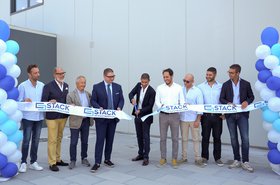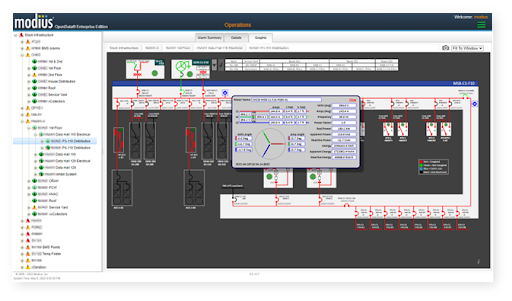Stack had a challenge, consisting of a very common and complex problem – hyperscalers require infrastructure that enables situational awareness, greater operational transparency and real-time, predictive performance data.
These hyperscalers are extremely demanding of what they need from their digital infrastructure providers, looking for fast, efficient solutions to meet rigorous SLAs and address a myriad of requirements, including access to live data center operations from a single portal.
Stack is on the leading edge of single-user buildings and campus developments, pairing state-of-the-art data center automation hardware with secure, comprehensive telemetry data service infrastructure.
These systems give operations teams performance analysis with consolidated and centralized operational status. And clients benefit from an on-demand window into the day-to-day health of the data centers.
These capabilities are critical in an increasingly competitive private data center marketplace that demands innovation and added value for owners and operators to stay relevant.
One of the most obvious areas where this can be achieved is through the provision of real-time situational awareness and API-forward data center telemetry.
As a result, Stack is growing rapidly. Really rapidly. So much so that it is quickly sourcing and constructing expansion capacity to keep pace with its accelerated growth.
The Stack requirement was for a software platform that delivers “collect once, reuse many times” analytics in a unifying architecture that can scale with the volume and disparity of data being delivered.
The days of creating and distributing independent reports from various point solutions no longer made sense. Stack needed its customers to have the ability to access live data center operational data from a single portal.
Stack was looking for a platform technology that could keep pace with its scale and growth. Modius offered such a platform, with features that would advance transparency, security, and support.
So, after a rigorous vetting of Modius OpenData against multiple, alternative solutions, Stack chose Modius due to its unique architecture – a future-proof solution built for scale and volume.
The Modius solution
Scale
The requirement to quickly scale was critical. In this rapid, ever-changing environment, the Modius technology and team are extremely nimble, enabling Stack to keep up with not just what it thinks it’s going to need, but what it will eventually need in the future.
Today, Modius OpenData is Stack's enterprise-grade solution for a massive infrastructure that continues to be heavily invested in through multiple build outs. Simply put, OpenData is the glue that ties it together.
Sustainability
Modius OpenData delivers not just data, but analytics that can be measured, transforming the data into meaningful operational metrics. Now Stack has the ability to drill down into every piece of critical hardware to see exactly its condition, power use, and efficiency level, bolstering corporate responsibility statements with quantified, hard data.
Security
While legacy ICS/Operational Technology systems are not renowned for their security, Modius encrypts data from the time it is initially received, all the way through to the database. Stack was looking to lean forward in the Operational Technology cybersecurity domain, so Modius’ NIST approved encryption and advanced solution were critical attributes.
Transparency
The market is requiring that digital infrastructure providers become much more transparent. The trend is toward greater customer transparency and greater end user engagement with the data center operator.
Historically, monitoring was integrated into new data centers after core components were installed and commissioned.
But today, comprehensive automation and telemetry are present in each existing Stack data center – thanks to Modius OpenData. The result? Transparency into data center health is a cornerstone of every new Stack facility.
Price
Because of its unique configuration model, Modius is able to deploy its software in a much more cost-effective manner than other technologies. Its user-configurable, repeatable templates save significant time and money.
Support
Modius offers a highly responsive, full service team that can truly be a part of a commissioning team that solves networking, connectivity, and data capture issues. In this way, Modius became Stack’s valuable partner, not just a technology provider.
Operational situational awareness through analytics
While data collection across a broad portfolio at scale is the critical foundation for today's DCIM solutions, the management and analysis of this data is the cornerstone of OpenData.
Stack used Modius OpenData to create real-time and historical analyses to provide both operators and customers with meaningful situational awareness.
In addition, ESG reporting mandates, operational efficiency expectations, and availability SLAs require rich analytics and data visualizations. Below are two examples of the customized presentations of data developed during the implementation.
Real-time operational dashboards
Power Usage Effectiveness (PUE) hourly averages, Total Critical and Facility Load trendlines are displayed alongside summaries in one compact, convenient dashboard.
Cooling subsystem performance is tracked and displayed in real-time, giving the customer actionable telemetry data structured in a way that makes sense for them.
EPMS
One-line drawings within the EPMS system provide a graphical representation of the state of each breaker, and inform the color of downstream lines.
These displays are very important to operators for quick evaluation of the state and health of the power systems. Operators can select a breaker with a mouse click which triggers a popup of breaker details such as breaker state and power measurement, and use this functionality to analyze system health and load profiles.
The bottom line
Optimized analytics means that Stack has an integrated portfolio-wide data set, and can compare and contrast trend performance over time, demonstrate SLA compliance, and offer self-serve analytics for customers.
Now Stack’s best-in-breed solution blends CRM service profiles with DCIM telemetry and health-state data, all in a single pane of glass, enabling unimpeded transparency for customers and operations teams.
Stack maintains 24/7/365 insight into tens of thousands of statuses – down to every sensor, circuit, and cooling fan.
With Modius OpenData, there’s a dashboard showing every status in real time, that’s easily accessible. Plus, report displays can be distributed using an automated schedule, providing real-time insight into all critical issues.
Point solutions are no longer viable solutions. Today, the requirement is for agile, scalable, massive data acquisition, all encrypted for security. And no one does that like Modius.
The 12-month roll-out saw the integration of the Modius solution into legacy building management systems and greenfield sites, creating a standardized and unified portfolio-wide framework for managing site infrastructure.
For the greenfield sites, Modius provided standard monitoring and analytics features, as well as its Electrical Power Management System (EPMS) for visualizing critical power assets.
“In addition to the portfolio-wide situational awareness we achieved with OpenData, we also implemented a Developer Portal publishing the OpenData API to provide our clients with the operational transparency they require,” said Val Milshtein, chief technology officer for Stack Infrastructure.
“Providing Stack clients with actionable, real-time data center telemetry services is just one example of how we’re adding value in a way other operators cannot.”
Mark Carberry, VP at Modius added, “By leveraging the configuration elements of OpenData, Modius customized the OpenData solution for Stack to meet the infrastructure team’s stringent requirements while maintaining project schedules, commissioning mandates, and cost-effective budgets.”
To find out more visit the Modius website here or email [email protected]
More from Stack Infrastructure
-

Stack opens third data center at Milan campus
Former Supernap Italia site continues to expand
-

Stack acquires land next to Hillsboro, Portland campus
Company expanding to 200MW in Portland campus
-

Stack moves into Australia, plans facilities in Melbourne, Perth, and Canberra
IPI-owned Stack takes over Hickory's data center developments


